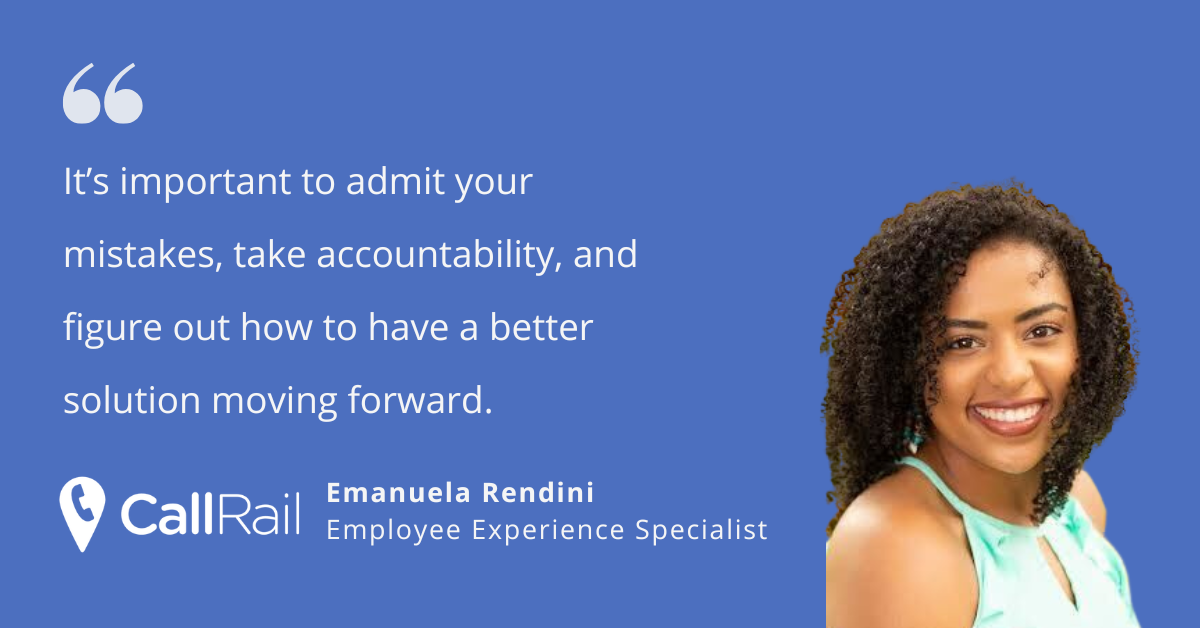The first thing you might notice about Emanuela Rendini is that she’s enthusiastic about communicating. Her love of communication comes from her drive to understand others and their needs.
“I love to help people,” explains Emanuela. “I love to ensure people have what they need.”
As an employee experience specialist at CallRail — a lead intelligence platform that helps businesses optimize their marketing — she gets to tap into employee needs and create initiatives to support those needs.
We sat down with Emanuela to discuss how she built her career in HR, how she participates in CallRail’s comprehensive DEIB culture, and her tips for how other HR professionals can work through a DEIB lens.
From Journalist to HR Professional
Her natural inclination to communicate led Emanuela to study journalism and go on to work as a TV News journalist. She loved it and felt passionate about communicating with the public, but long hours led to burnout, which she says is common in journalism.
Knowing that she would need to make a career pivot, Emanuela completed an MBA with a focus on HR. It was easy for her to envision herself as an HR professional, and her vision turned out to be right.
“I felt like I would be great in HR, and I’ve loved it from the start,” she says. “I've been in different roles within HR, but no matter what position I've been in, it always feels like I'm in the right place at the right time of my life.”
Later on, a friend who worked at CallRail kept telling Emanuela how much he loved working there and how diverse the CallRail team was. Given how often she was one of the sole Black women within a department, Emanuela’s interest was piqued.
Every single HR job I've held, I've always been the only minority on my team. So it was really interesting to see a team that was actually diverse, in all kinds of ways,” says Emanuela.
As she went through the recruitment process, every step made her more certain that CallRail was where she wanted to be. While speaking with a trusted family member, Emanuela drafted a list of pros and cons of the job.
“They said, ‘Okay, those are your pros, now what are your cons?’ And I couldn't give any,”
Emanuela laughs.
HR Through “DEIB Goggles”
In former positions, Emanuela participated in DEIB initiatives, but CallRail’s holistic approach has taught her to use what she calls her “DEIB goggles” to create safer and more inclusive workplaces.
“CallRail has helped me see HR through my DEIB goggles,” she explains. “In meetings I’ll say, ‘That's a great idea, but it's not inclusive, so let's figure out a way we can make that inclusive. What I love about CallRail is that everyone is on board with that.’”
Emanuela thinks about her work in the context of what she calls the “life cycle of an employee.” That life cycle begins the moment that first recruitment ad is posted, and lasts until the employee who was hired as a result of that ad moves on or retires.
“I focus on the employee experience from beginning to end of that life cycle,” says Emanuela. “At every step of that employee’s experience, I have to ask myself: ‘Are we being diverse? Are we being equitable? Are we being inclusive? Do they have a sense of belonging?’”
As an employee experience specialist, Emanuela oversees the many Employee Resource Groups (ERGs) at CallRail. She gets a lot of satisfaction from seeing that these ERGs, when managed intentionally, allow employees to feel seen and heard.
“One of the biggest ways I am helping to foster diversity and inclusion is managing our ERGs. These networks of employees not only form communities, but they each have measurable mission statements, and I help them to produce results,” she says.
For Emanuela, ERGs also provide excellent feedback on a company’s overall DEIB performance.
“Our ERGs help us to see things that we didn't catch before. It's important to create spaces where the words and experiences of diverse individuals carry value and initiate change,” she says.
3 Tips For Navigating DEIB In HR
As the liaison between the employee and the company, HR must balance the needs of both, explains Emanuela.“It's not always easy to meet the needs of both the company and employees. It's never going to be black and white,” she says.
With that in mind, here are her top tips for fostering diversity and inclusion as an HR professional:
- Get comfortable with not having all the answers. Emanuela advises: “Live in the gray, get comfortable with the gray, and understand how to navigate the gray. Humans are complex creatures and the world is nuanced. The best way to create safe spaces is to involve them when deciding what that looks like.”
- Educate yourself on DEIB best practices and hot button issues. The good thing about living in the information age is that when you don't know something, you can seek the answer. “There's plenty of consultants, there's plenty of books, there's plenty of programs, there's plenty of certifications,” adds Emanuela.
- Be kind to yourself when you make mistakes. Because you will. Mistakes are inevitable in DEIB work. The important thing, Emanuela says, is to figure out how you're going to learn from the experience and do better next time. She explains: “It’s important to admit your mistakes, take accountability, and figure out how to have a better solution moving forward. Part of DEIB is not giving up just because it didn’t go the way you wanted the first time.”
If you’re looking to join a diverse and evolving team, CallRail is hiring!




